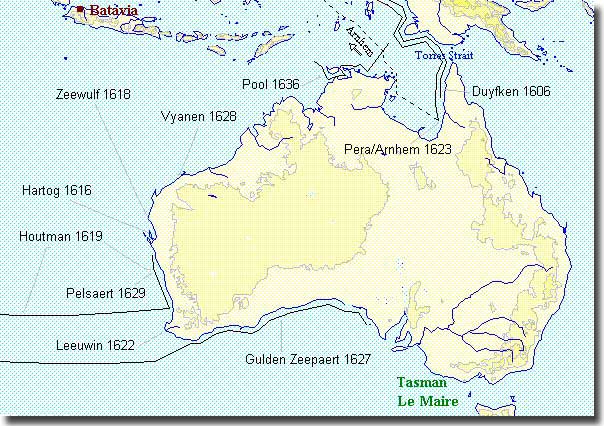|
Early Dutch Explorers on the Australian Coast 1606 - 1636
The first Europeans to visit Australia were not the English navigators but came from Holland. During the 15th. and 16th. centuries it was the Spanish, Portuguese and the Dutch seamen that pushed back the exploration frontiers. After finding South America, it was Magellan who first sailed into the Pacific Ocean, and New Guinea was first sighted by the Portuguese, and as early as 1605, the Dutch vessel Duyfken made the first landfall on the Australian coast. This ship sailing along the south coast of New Guinea and into the Torres Strait turned southwards to sail along the Cape York Peninsula. In 1616, Dirk Hartog in Eendracht came upon islands off the West Australian coast, the largest of which bears his name, and he nailed up a pewter plate to a post to record his visit here. In 1618, some of Zeewulf's crew landed on the coast nearby Hartog Island, and the Dutch ship Leeuwin made a landfall on the South West corner of Australia to name Cape Leeuwin in 1622. It is at this spot that the Indian Ocean cojoins the great Southern Ocean, and it is a wild and windswept place. Jan Carstanz with the ships Pera and Arnhem, was next in 1623, exploring the area named after one of the vessels Arnhem Land, but the crew of the latter ship all mutinied leaving Carstanz in Pera to continue alone. A number of other Dutch ships continued to reach Australia, and chart some of the coastline, these include Gulden Zeepaert, Vyaneu and the infamous Batavia. This last ship, brand new and owned by the Vereenigde de Oost-Indiche Compagnie ( VOS ) was on her maiden run making for Batavia. She was ship wrecked on a reef off the Western Australia coast on the 4th. of June 1629. The crew made it to a nearby small coral island devoid of food or water, and the merchant leading the expedition Pelseart, sailed one of the ship's boats to Batavia, returning in a larger ship to rescue the survivors. In the interim, a mutiny had taken place, and the mutineers murdered many of the survivors to reduce the numbers dependent on the small amount of food and water salvaged from Batavia, so that they might survive. Pelseart on his return tried the ring leaders, and hung a number of them, first cutting off their hands prior to their hanging. Some of the mutineers were returned to Batavia where the Governor General extracted a dreadful vengeance on them. Abel Tasman had been sent by van Dieman to explore Terra Austalis, he made his first sighting on the west coast of Tasmania which was then named van Dieman's Land in 1642 after his boss, he then went on to discover New Zealand. Two years later Tasman sailed north along Cape York Peninsula. The subsequent map indicates the various Dutch explorers, where and when they landed on the Australian coast. My country might well speak Dutch rather than English, it took the British explorer Captain James Cook until 1770 to discover and claim for England the east coast of Australia.
Back to index of early Australian explorers |

